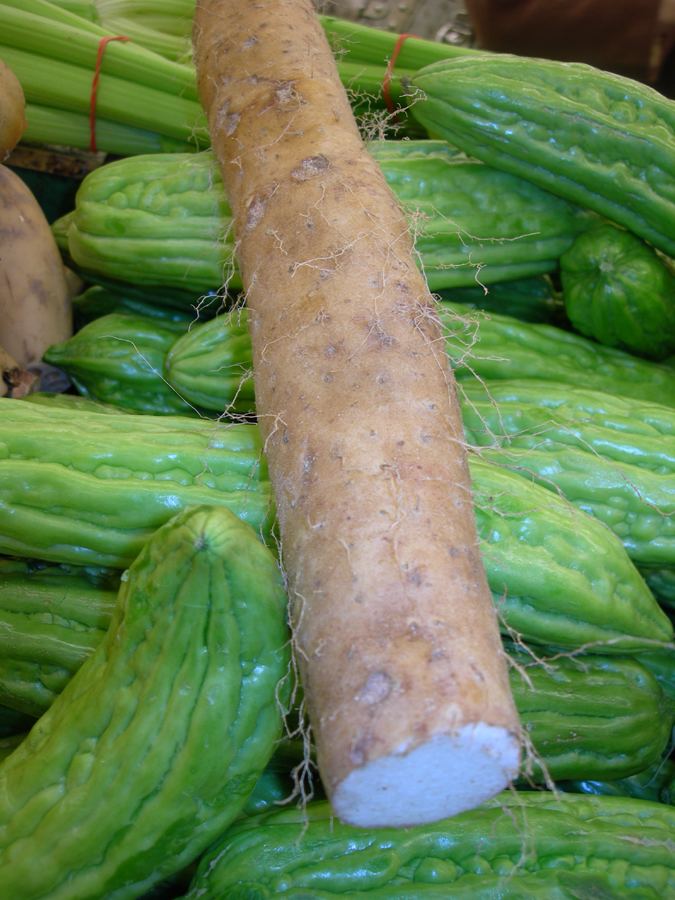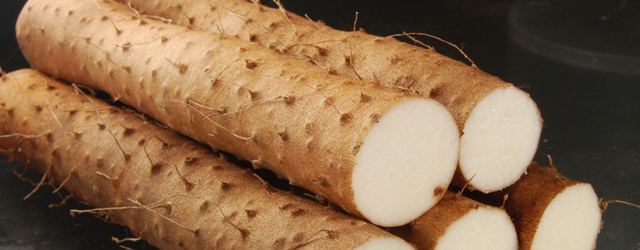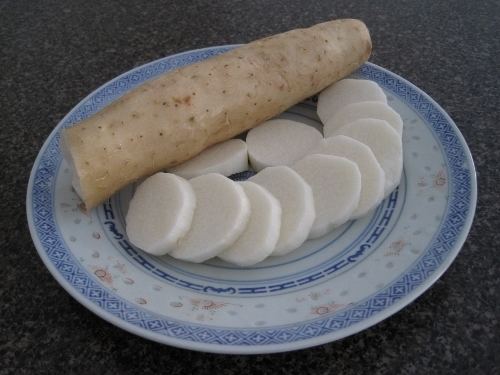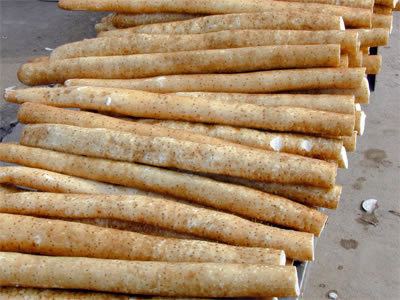Scientific name Dioscorea polystachya | Genus Dioscorea Rank Species | |
 | ||
Similar Dioscorea japonica, Taro, Tremella fuciformis, Adlay, Coix lacryma‑jobi | ||
Chinese yam its health benefits
Chinese yam (Dioscorea polystachya), also called cinnamon-vine, is a species of flowering plant in the yam family. This perennial climbing bine native to China now grows throughout East Asia (Japan, Korea, Kuril Islands, Vietnam). It is believed to have been introduced to Japan in the 17th century or earlier. Introduced to the United States as early as the 19th century for culinary and cultural uses, it is now considered an invasive plant species. The plant was introduced to Europe in the 19th century during the European Potato Failure, where cultivation continues to this day for the Asian food market. The edible tubers, often called nagaimo or Chinese-potato, are cultivated largely in Asia and sometimes used in alternative medicine. This species of yam is unique as the tubers can be eaten raw.
Contents
- Chinese yam its health benefits
- Chinese yam
- Taxonomy
- Description
- Names
- In alternative medicine
- As an invasive species
- Uses
- Growing Chinese yam
- References

Chinese yam
Taxonomy

The botanical names Dioscorea opposita and Dioscorea oppositifolia have been consistently misapplied to Chinese yam. The name D. opposita is now an accepted synonym of D. oppositifolia. Botanical works that point out the error may list, e.g., Dioscorea opposita auct. as a synonym of D. polystachya. Furthermore, neither D. oppositifolia nor the prior D. opposita have been found growing in North America and have no historical range in China or East Asia, this grouping is native only to the subcontinent of India and should not be confused with Dioscorea polystachya.
Description

Dioscorea polystachya vines typically grow 3–5 meters long, but can be longer. They twine clockwise. The leaves are up to 11 centimeters long and wide. They are lobed at the base and larger ones may have lobed edges. The arrangement is variable; they may be alternately or oppositely arranged or borne in whorls. In the leaf axils appear warty rounded bulbils under 2 centimeters long. New plants sprout from the bulbils or parts of them. The flowers are cinnamon-scented. The plant produces one or more spindle-shaped or cylindrical tubers. The largest may weigh 10 pounds and grow one meter underground. Dioscorea polystachya is more tolerant to frost and cooler climates than other yams, which is attributed to its successful introductions and establishment on many continents.
Names
In Chinese it is known as huáishān (怀(淮)山), shānyào (山药, 山藥) (lit. "mountain medicine."), or huáishānyào (怀(淮)山药, 怀(淮)山藥)(lit. "mountain medicine from Huai", i.e. Huai Qing Fu (怀庆俯) region). Rarely, also referred to as shǔyù (薯蕷).
In Japanese, it is known as nagaimo (lit. 'long yam'; kanji: 長芋). Furthermore, nagaimo is classified into ichōimo (lit. 'ginkgo-leaf yam'; kanji: 銀杏芋), or yamatoimo (lit. Yamato yam; kanji: 大和芋), depending on root shapes. In Japan, this species is sometimes mistakenly called Japanese mountain yam, which refers to the native Dioscorea japonica.
In Korea it is called ma (hangul: 마), "sanwu (山芋, 산우)", seoyeo (薯蕷, 서여), or sanyak (山藥, 산약) and in Sri Lanka in Sinhala it is called wal ala (වැල් අල). Sometimes called Korean yam.
In Vietnam, the yam is called củ mài or khoai mài. When this yam is processed to become a medicine, the yam is called hoài sơn or tỳ giải.
In the Ilocano of the northern Philippines it is called tuge.
In Latin American countries it's known as white name or white ñame.
In alternative medicine
Creams and dietary supplements made from the related Dioscorea villosa are claimed to contain human hormones and promoted as a medicine for a variety of purposes, including cancer prevention and the treatment of Crohn's disease and whooping cough. However, according to the American Cancer Society, the claims are false and there is no evidence to support these substances being either safe or effective. Huáishān has also been used in traditional Chinese medicine.
As an invasive species
Dioscorea polystachya was introduced to the United States in the 1800s when it was planted as an ornamental or food crop. It and other introduced yam species now grow wild there. It is troublesome in Great Smoky Mountains National Park, where its range is "rapidly expanding". It is most prevalent in moist habitat types. It is more tolerant of frost than other yams and can occur in temperate climates as far north as New York.
Uses
The tubers of D. polystachya can be eaten raw, while other yams must be cooked before consumption (due to harmful substances in the raw state). In Japanese cuisine, it is eaten raw and grated, after only a relatively minimal preparation: the whole tubers are briefly soaked in a vinegar-water solution, to neutralize irritant oxalate crystals found in their skin. The raw vegetable is starchy and bland, mucilaginous when grated, and may be eaten plain as a side dish, or added to noodles.
It is used in the Japanese noodle dish tororo udon/soba and as a binding agent in the batter of okonomiyaki. The grated yam is known as tororo (in Japanese). In tororo udon/soba, the tororo is mixed with other ingredients that typically include tsuyu broth (dashi), wasabi, and green onions.
Growing Chinese yam
The Huáishān growing cycle spans approximately one year, and should be planted between winter and spring. The traditional methods growing it are: using smaller tubers, top cut of bigger tubers or through cuttings of branches. The first two methods can produce 20 cm (7.8 in) long tubers and above. The latter produces smaller tubers (10 cm or 4 in) that are usually replanted for the next year.
Between 7 and 9 months of replanting huáishān seedlings, their leaves start to get dry (a common fact in plants that grow tubers): that indicates that it's time to harvest. In home gardens generally only what will be consumed is harvested, with the rest left in the pot in moist soil.
